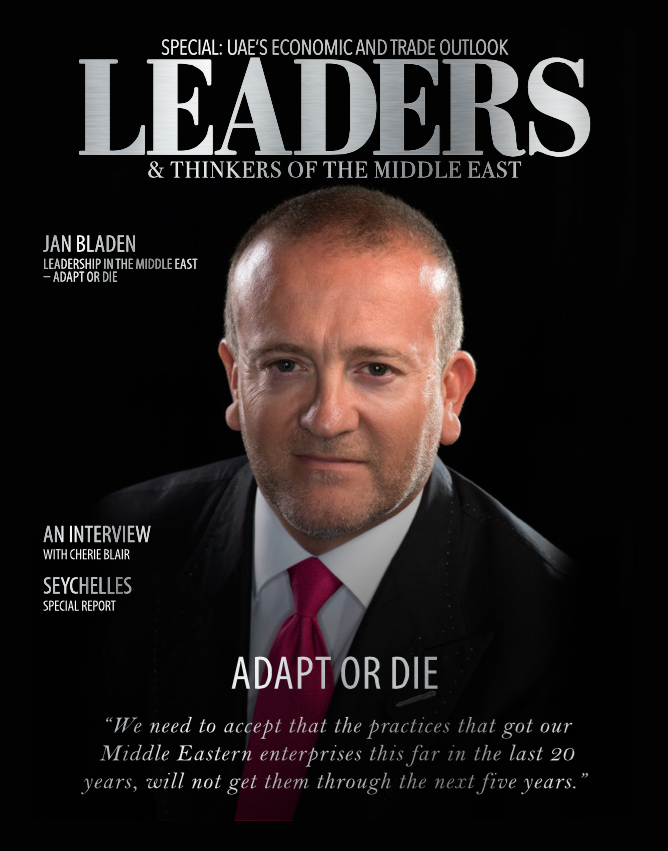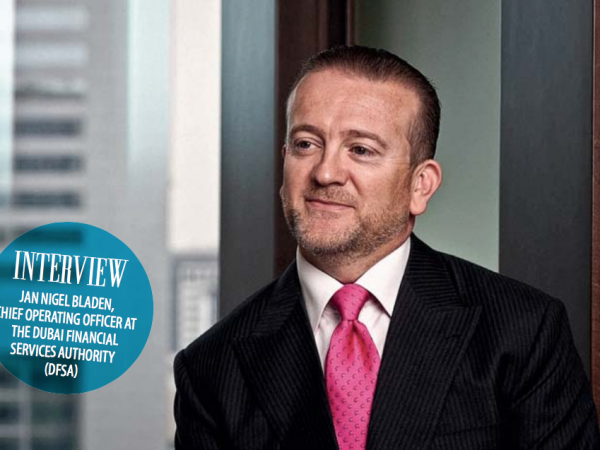Jan shares his insights into the challenges faced by CEOs in the Middle East as they navigate cultural barriers, talent shortages and corporate governance in the name of growth and shareholder value.

Jan Bladen the former Executive Advisor and Program Lead to the Abu Dhabi Global Market and founding Chief Operating Officer of the Dubai Financial Services Authority, shares his insights into the chal- lenges faced by CEOs in the Middle East as they navigate cultural bar- riers, talent shortages and corporate governance in the name of growth and shareholder value.
Talent management, cost and operational efficiency, governance progress and cultural evolution are four core challenges facing any ambitious CEO in the Middle East as he seeks to unlock growth and shareholder value over the next 10 years. Add to this the continued regional geopolitical instability, the arrival of international competition, the rising cost of living implications and dropping oil revenues, and the task will challenge the leadership skills of even our most driven CEOs in the region.
For State Owned Enterprises and Family Business, their task is equally challenging: Identifying the CEO who has the abilities to unlock value within this challenging environment, while accepting the businesses practices that got us to where we are now are not the business practices we need to get to where we need to be tomorrow. Organisations need somebody that can migrate and evolve family and state businesses from their current position to being world class, and to do it without upsetting the cultural applecart.
Talent Management
If you accept that Talent is one of the most important drivers of a successful business then ensuring you possess the right human talent may be one of the harder nuts to crack. Attracting new skilled expatriate employees to the Middle East has become more challenging as the constant geopolitical news creates an adverse image of the region, while retaining current employees in the face of the UAE’s rising cost of living (HSBC’s 2014 Annual Expat Survey highlights the UAE›s rising cost of living as a primary concern for expats) is an additional challenge for any CEO who wants to drive revenue growth and shareholder value.
So how do we attract much needed talent to the region, pay above market rates, and beyond set budgets, for scarce and important talent that won›t join otherwise? And is this scarcity of talent not enigmatic when youth unemployment across the region averages 25 per cent? A recent article by Egon Zehnder explains this well, suggesting that there is simply a mismatch between the skills Middle
Eastern education systems provide and those that firms actually need. One solution to the challenge is to seek-out and train local UAE Talent and this solution is often countered by arguments around the cost of the private sector competing against Government who pay above market rates, offer shorter hours and longer holidays to local talent.
But the statistics don’t lie: Nearly 50 per cent of all UAE Nationals employed in the workforce are female and the number of UAE women enrolled in higher education is 24 per cent higher than the number of UAE men. Further, 77 per cent of UAE females continue on to higher education from high school and this year alone make up 75 per cent of the student body at the national university in Al-Ain. If this trend continues then the UAE will become “An Amazon State” and any CEO worth his weight should already be thinking of how to ensure his organisation reaps the benefits of this pool of young, ambitious, Emirati female talent.
In 2006, in my position as Founding Chief Operating Officer of the Dubai Financial Services Authority, the DFSA launched its Tomorrow’s Regulatory Leaders (TRL) Programme. We had recognised the opportunity to make a contribution towards the UAE’s Emiratisation initiative while, more importantly, investing in developing our own pool of young Emiratis to become leaders in the financial and regulatory sector. Some 10 years later, that programme is now recognised as an outstanding achievement and a leading example of successful private sector Emiratisation. Likewise, on my departure from the DFSA, nearly 30 per cent of the regulatory staff was highly skilled and performing Emiratis, up from none, with a large proportion of its graduates being Emirati ladies.
CEOs must now recognise Emiratisation as a positive solution by creating your own development programs to produce your own pool of future expertise and talent.
Possibly the number one under-utilised commodity of the UAE is local female Emirati talent.
Governance progress and cultural evolution
To date, the implementation of Corporate Governance in the Middle East has not been successful, simply because it was not needed. The fact that the majority of larger organisations are either family or state owned, coupled with easily available liquidity and financing from banks, meant that there was no financial motivation to adopt corporate governance. Actually, quite the opposite; The Middle East has always treasured a certain amount of discretion, which culturally clashes with the transparency requirements of typical western cor- porate governance standards.
According to a recent article by Mishal Kanoo (The Kanoo Group Dep- uty Chairman), many Gulf families are not prepped for the rigours and challenges associated with an IPO and the related governance require- ments. Overt transparency along with Governmental and Regulatory Body oversight is not something your typical family businesses in the region are used to.
While the family-owned structure results in greater control, it does create challenges as the business passes from one generation to an- other. “Western” corporate governance may therefore not be the best solution for all in the Middle East, however some form of culturally adapted corporate governance improvements need to take place, if not for an IPO, then simply to assist family-owned businesses to improve competitiveness, lower the cost of capital, strengthen operational performance, diversify their boards and improve strategy and decision making so as to counter the increased competition from global organ isations entering the Middle East. Add to this the fact that international investors are willing to pay a substantial premium for well governed organisations also means that the Middle East represents a substantial source of untapped corporate wealth.
Cost and Operational Efficiency
The GCC’s historical high runaway growth from 2000 to 2007 was not accompanied by a strengthening of operational management prac- tices. Quite the opposite; inadequate management practices were overloaded with ever increasing sales and revenue growth, with lim- ited improvement in operational policies and procedure, and very few examples of economies of scale. The operational foundations were groaning and creaking under the strain and pressures, and our ser- vice quality levels plummeted.
Both revenue growth and operational cost efficiency drive shareholder value, but research demonstrates that operational cost efficiency mat- ters more. Increasing the revenue without fixing the efficiency issues has a limited impact and only further increases complexity. Cost and operational efficiency is simply the capability of an enterprise to de- liver products, services and support to its customers in the most cost- effective manner possible while still ensuring high quality.
It is often realised by streamlining a company›s core processes, mini- mizing redundancy and waste, and utilising the best of its workforce and technology to achieve more with less, while also responding pro- actively to continually changing market forces in a cost-effective man- ner. The reduced internal costs that result from operational efficiency
enable a company to achieve higher profit margins or be more suc- cessful in defending and acquiring market share in highly competi- tive markets.
Historical monopolistic practices and market protection within the Middle East region has naturally limited the need for many organisa- tions to evolve and compete from either an operational efficiency per- spective or a financial effectiveness viewpoint. Low cost of labour, with little or no tax overheads and a protected environment has resulted in many Middle Eastern organisations simply not needing to seek opera- tional efficiencies or cost leadership positions. Our historical approach to resolving operational constraints was to take the most practical and cheapest approach at that time: simply add more cheap labour to the equation. However, more labour, with no improvement in either man- agement structures, governance or operational efficiency, will finally lead to what economists call diseconomies of scale, – the forces that cause larger inefficient organisations to produce goods and services at increased per-unit costs.
Times in the region are changing rapidly. The arrival of international competition operating with a low- er weighted average cost of cap- ital due to better corporate gov- ernance and consequently better credit ratings, will allow interna- tional players to compete with lo- cal market rates while maintain- ing strong margins. Even worse, these international competitors have become experts in seeking operational efficiencies and cost effective operations that deliver what the client needs, with nothing more and nothing less.
As the legal and monopolistic barriers to entry shrink and international competitors learn to understand the cultural requirements of the re- gion, plugging the operational “gap” for Middle Eastern organisations between current practices and good practices will not be easy. We will need to start by accepting that the practices that got our Middle East- ern enterprises this far in the last 20 years, will not get them through the next 20 years. This unwillingness to adapt (“we›ve always done it this way, so there›s no need to ever change”) can also be lethal: Po- laroid Corporation refused to move into digital imaging until after this resistance to change had severely affected the company. By the time Polaroid finally accepted that it needed to adapt it was too late, with the corporation finally declaring bankruptcy.
All other factors remaining equal, the upside to operational efficiency is a more competitive organisation that is better run, more resilient, with higher margins and generating sustained longer term sharehold- er value in the face of growing competition. Charles Robert Darwin (1809 – 1882) was an English naturalist and geologist, best known for his contributions to evolutionary theory and some research has sug- gested parallels may be draw between corporate evolution and bio- logical evolution. Many academics have paraphrased Darwin’s work Origin of Species, as: “It is not the most intellectual of the species that survives, nor is it the strongest that survives. It is the one that is able best to adapt and adjust to the changing environment in which it finds itself.” Adapt, or die?









